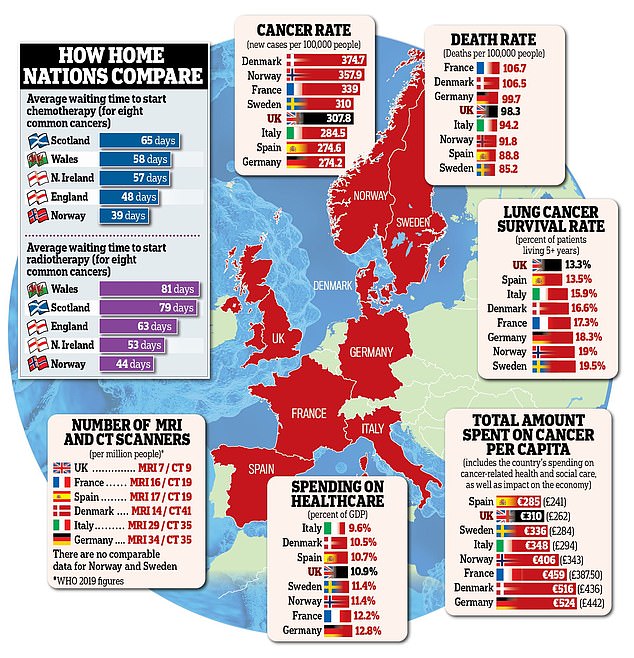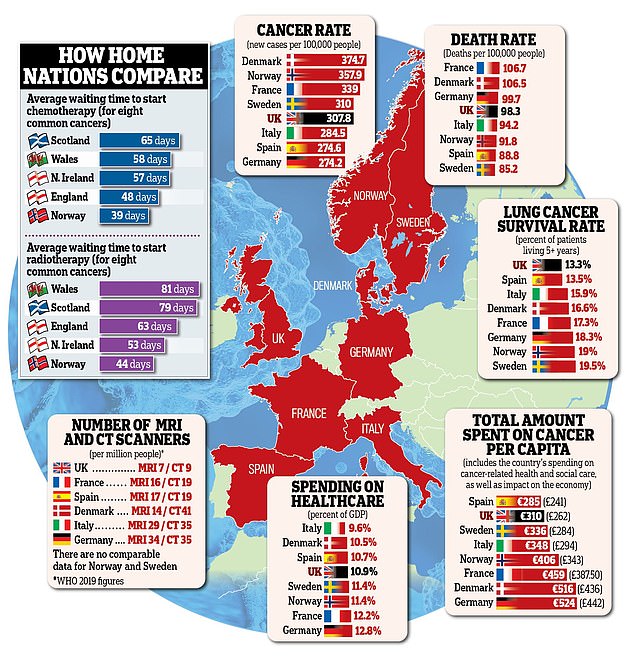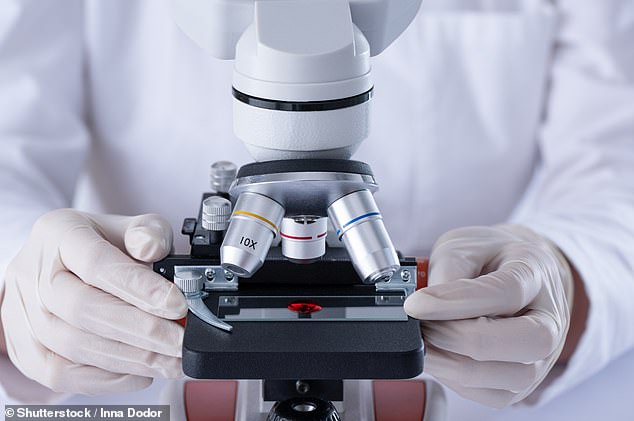Why Britain is one of the worst places to get cancer in Europe – with among the lowest survival rates, long waits for treatment and tumours caught later than anyone else



It’s a worrying trend that shows no sign of abating: cancer rates across the UK are on the rise, having shot up by 13 per cent in the past 25 years.
More worrying still is that, according to Cancer Research UK, the biggest rise is among the under-50s, among whom cases rose by 24 per cent between 1995 and 2019.
This isn’t solely a UK trend. Across Europe, cancer rates among those of all ages have risen on average almost 50 per cent in the past two decades.
In fact, despite forming less than a tenth of the world’s population, Europeans – around 750 million people – account for about a quarter of all global cancer cases.
But while the incidence of cancer seems to be a problem shared – with the rise largely due to ageing populations and increasingly unhealthy lifestyles – the fate of those who develop cancer varies greatly from country to country.

A Good Health investigation has found that the UK ranks as one of the poorest performers compared with its continental neighbours
A Good Health investigation has found that the UK – frequently dubbed the ‘sick man of Europe’ – ranks as one of the poorest performers compared with its continental neighbours, with reports showing its cancer survival rates lag way behind many others.
For example, in the UK today, patients with common cancers have the same survival rates as those living in Sweden, Denmark and Norway did some 20 years ago, according to the charity Macmillan Cancer Support.
And a September 2023 report by the Institute for Public Policy Research estimated that 240,000 lives could have been saved over the previous decade if UK cancer and dementia death rates had been on a par with major European countries.
The report blamed long waits for treatment and a failure to properly tackle the causes of cancer – from obesity to couch potato lifestyles and smoking.
Given that, here we reveal just how poorly UK cancer care compares with our nearest neighbours, and – crucially – what we can learn from them about how to make it better.
The countries were chosen for a variety of reasons, such as recent dramatic improvements in cancer survival and having higher healthcare spending than the UK.
UK
Population: 67.6m
The UK has seen year-on-year improvements in survival rates since the 2000s, but it still has a lot of catching up to do.
Lung cancer is the most common cause of cancer deaths to affect both men and women – and is the deadliest cancer worldwide. As a metric of cancer care, the UK’s five-year lung cancer survival rate at just 13.3 per cent is the worst of all the eight countries we studied – and is lower than the rate was in Sweden a quarter of a century ago (Sweden’s rate is now nearly 20 per cent).
‘We take longer to deliver treatment, deliver less treatment and, in some cases, deliver it less well,’ says Dr John Butler, lead clinical adviser of the International Cancer Benchmarking Partnership, which studies how countries across the world perform.
The NHS’s lower capacity to carry out tests is part of the problem, he says, driven by having less diagnostic equipment.
The UK has a fraction of the number of MRI scanners (used to help diagnose cancer and the size and location of tumours) that poorer EU countries have, such as Italy for example.
While Italy has 29 MRI scanners per million people, the UK has seven per million. And whereas Italy has 35 CT scanners (used to detect lung and colon cancers) per million people, we have nine per million. ‘This makes a huge difference in our ability to diagnose,’ says Dr Butler, who is also a clinical adviser for Cancer Research UK.
On top of that, shortages of imaging and nursing staff mean it may not be possible to use the machines we do have at full capacity. Almost 13 per cent of all diagnostic radiographer jobs in England are unfilled, for instance, according to a Workforce Census in 2022.
Of the eight countries, as well as having the least diagnostic equipment per person, the UK also has the lowest levels of radiotherapy machines for treating cancer – around half of diagnosed cancer patients will undergo radiotherapy performed by this type of machine.
Professor Karol Sikora, one of the world’s leading cancer specialists and currently a consultant oncologist based in London, believes the UK’s poor performance starts with delays in patients being able to see a GP and get a referral for tests.
Studies suggest our GPs, under pressure to ration services, are less likely to refer patients with the same symptoms than their Scandinavian counterparts.
‘The whole system is just not geared up to treat people quickly,’ adds Professor Sikora. ‘It doesn’t cost more to do a scan next week than in three months’ time, but the impact of cancer progressing in that time can be significant.’
Cancer cases in the UK are more likely to be diagnosed at a later stage, too – when chances of survival are lower – and studies show UK patients often wait up to five weeks longer to start treatment than those in Norway, for instance.
The UK spends less on cancer medicines compared with most other countries assessed here.
Yet we have the highest obesity rates, smoking rates and alcohol-related cancer deaths in men.
And it’s the only country of the eight without a national cancer plan, after the National Cancer Control Plan in England and Wales was scrapped last year and subsumed by a wider ‘major conditions strategy’ which covers multiple conditions.
A spokesman for the Department of Health and Social Care told Good Health it plans to ‘hit all NHS cancer waiting times and early diagnosis targets’ within five years and double the number of MRI and CT scanners – but stopped short of committing to a national cancer plan.
‘We have inherited a broken NHS. Too many cancer patients are waiting too long for treatment and we are determined to change that,’ the spokesman added.
DENMARK
Population: 6m
Like the UK, Denmark’s cancer survival rates compared poorly with the EU average during the 1990s, but it invested heavily in reforming services through a series of national cancer plans supported by successive governments.
Now almost 17 per cent of its lung cancer patients survive beyond five years (up from 9.5 per cent in 2004), whereas in the UK only 13 per cent do (up from 8.3 per cent in 2004).
‘Denmark has seen huge investment, consistent leadership and the political will to focus on improving [cancer] outcomes,’ says Dr Butler.
Denmark has focused on improving early detection, making it easier for GPs to refer suspected cancer cases for a range of diagnostic tests – such as scans or endoscopies (where a camera is inserted into the body).
In the UK, GPs often have to refer patients for each type of test separately, which can cause delays.
In terms of treatment, Denmark also now has the highest ratio of radiotherapy machines to population out of the eight countries here, with 9.5 machines per million people, compared with just five per million in the UK.
It has moved treatment to national specialist centres, so patients see experts in their type of cancer, and cut red tape to ensure innovative medicines get approved faster.
Its high cancer rates (with 374.7 people per 100,000 population getting the disease, compared with 307.8 in the UK) are thought to reflect efficient screening and diagnosis – in other words, the cancers are being spotted early.
However, Denmark does also have higher rates of smoking and alcohol consumption than many neighbouring nations.
ITALY
Population: 59m
Italy is one of the poorer Western European nations and its healthcare system faces staffing and funding issues. This may explain why cancer survival rates have improved slower than in the other countries.
Italy’s five-year lung cancer survival rates rose only slightly, from 14 per cent to 15.9 per cent, between 2004 and 2014. Even so, it still performs better than the UK.
The country’s health system is run on a regional basis, so while some states start routine breast cancer screening in women from 45 and continue until 74, others screen from between the ages of 50 to 69.
But a major shake-up in 2011 standardised national cancer
care and led to improvements, particularly in the survival rates of breast and prostate cancers.

The report blamed waits for treatment and a failure to properly tackle the causes of cancer
Italy now has the highest levels of oncologists in Europe – 4.5 per 100,000 adults – and a national oncology plan, launched last year, aims to bring cancer care in line with its European neighbours.
‘In Italy, you can also book an appointment to see a GP in a few days, get a scan and start treatment a week later,’ says Professor Sikora.
‘They have more capacity to diagnose patients than us. In the UK, waiting to see and then get referred by a GP causes significant delays.’
Italy has lower diagnosis rates of some cancers, which may reflect a poor take-up of cervical and bowel cancer screening – but it may also reflect Italians’ healthier lifestyles, with relatively low smoking, drinking and obesity levels.
Only around a fifth of Italians are obese, compared with nearly a third in the UK, and their diet – rich in olive oil, fresh fruit and vegetables, pulses, nuts, seeds and fish – can, some studies suggest, reduce the risk of some cancers by up to two-thirds.
GERMANY
Population: 83.5m
As in the UK, four in ten new cancer cases here are preventable, with nearly one in five caused by smoking, and one in 14 linked to obesity.
But mortality rates for most cancers in Germany have dropped significantly since the mid-1990s, thanks to improved diagnosis and treatment.
‘There is better and faster diagnostic capacity,’ says Professor Sikora, who points out that Germany has 34 MRI and 35 CT scanners per million people, while the UK has just seven MRI scanners and nine CT scanners per million.
Germany’s national cancer plan, in place since 2008, ensures treatments are efficient and has helped overcome discrepancies in care between its 16 states.
Germany was an early adopter of bowel cancer screening, with some areas implementing it in the over-55s back in 2002. As a result, Germany has seen deaths from bowel cancer decline by up to 26 per cent since then.
By contrast, the NHS has screened people in their 60s only since 2006, though there are plans to extend this to everyone from age 50 by 2025.
Germany spends more than any of the other countries here on cancer medications, at around £77 per head of population annually, nearly double the £41 spent in the UK. Studies suggest this may be due to its quick approval systems for new medicines and a lack of price regulation. This means that new drugs are often launched there first but cost more.
FRANCE
Population: 68.4m
France is considered one of the best countries in the world at tackling cancer, despite some regional disparities. It spends 12.2 per cent of its GDP
on healthcare, compared with 10.9 per cent in the UK, and its cancer mortality rates have declined in the past two decades.
‘In France, you can often see someone [i.e. see a GP and get referred for treatment] the next day,’ says Professor Sikora. ‘In the UK, it has been getting harder to see a GP.’
The French government passed a law in 2019 requiring the health service to meet 240 objectives on cancer – including reducing mortality – and has set a target to carry out a million extra screening tests per year by 2025.
Meanwhile, its breast cancer screening programme covers women up to 74 – the most extensive of all eight countries.
But it does have a relatively high cancer rate – especially lung and alcohol-related cancers in men.
While smoking levels are dropping, they are still the highest of all eight countries here – a third of French men and more than a fifth of women smoke. In the UK, only a fifth of men and just under a fifth of women smoke.
NORWAY
Population: 5.6m
Norway has seen a marked improvement in cancer survival rates over the past two decades. It increased its number of oncologists by 70 per cent between 2005 and 2015 (to 4.2 per 100,000 – higher than most EU countries) and has a high proportion of radiotherapy treatment machines per person, with 8.3 units per million people, compared with five per million in the UK.
It also spends more on cancer care than the EU average (the total cost of cancer in Norway is €296 per capita, compared with the EU average of €195, and €176 – £149 – in the UK).
During the pandemic, cancer treatment was prioritised, so delays were minimised, while in the UK the number of diagnostic tests for colorectal cancer, for example, dropped by 92 per cent, according to Cancer Research UK.
Norway has also had a national cancer strategy since 2012 which focuses on improving quality of life, survival rates and pioneering new prevention measures.
‘In the UK, if a GP suspects cancer they have to write to the hospital to request a test, then the hospital will send an appointment to the patient,’ explains Professor Sikora.
‘But in countries such as Norway, systems are streamlined so a patient can be instantly booked in for all their tests by the GP who suspects cancer.’
Norway also has a much better uptake of the HPV (human papillomavirus) vaccine – to prevent cervical and other oral and genital cancers – with around 94 per cent of teens there getting at least one dose, versus 76 per cent of girls and 70 per cent of boys in the UK.
On the other hand, the country only introduced bowel cancer screening in 2022 (2006 in the UK) and only 8 per cent of those eligible have so far had a test (70 per cent in the UK).
SPAIN
Population: 48.6m
Spain has some of the lowest rates of cancer (particularly among women) and cancer deaths in Europe.
It’s not clear why, though, as it invests less than other countries
in healthcare, its obesity rates are climbing, smoking rates are second only to France – and a fifth of the men drink alcohol every day. In fact, it has the highest number of cancer deaths linked to alcohol out of the eight countries here.
However, it does have more doctors on average: 4.6 per 1,000 people, compared with 3.2 per 1,000 in the UK.
And in 2006, Spain published its first national cancer plan (since updated in 2021), which focused on prevention, introducing better medications, creating specialist centres for rare and complex cases, investing in research and evening out regional disparities – although some patients have to travel long distances to access specialist cancer centres.
Spain’s success is mostly due to progress in treating late-stage cancers. Survival rates among women with advanced breast cancer rose from 36 per cent at the start of the 2000s to 43 per cent by the early 2010s, partly as a result of wider use of precision medicine, where treatments are tailored to individual patients based on tumour type, genes, environment, lifestyle and other health conditions, instead of a one-size-fits-all approach.
SWEDEN
Population: 10.6m
Sweden has some of the best cancer survival rates in Europe – seven in ten patients are still alive ten years after diagnosis.
Nearly 20 per cent of lung cancer patients live at least five years, compared with just over 13 per cent in the UK.
Its success is partly due to investment in a national cancer scheme in 2015, focused on reducing waiting times for diagnosis and treatment. This sets out more than 30 standardised care ‘pathways’ which specify strict maximum waiting times – for example, a patient suspected of having breast cancer must be diagnosed and begin treatment within 28 days.
Sweden also has ambitious national screening programmes, with women aged 50 to 69 screened for breast cancer every 18 to 24 months. In the UK it’s every three years.
But regional differences remain – Stockholm residents, for example, have had routine bowel cancer screening since 2008, but other areas won’t get it until 2026.
Studies show the pandemic had no major effects on cancer care in Sweden – which did not introduce strict lockdown measures – whereas there were major delays to tests and treatment in the UK.
Sweden has relatively low obesity and smoking rates and some of the cleanest air, so it’s no surprise lung cancer rates are low at 16.9 per 100,000 adult men – a third of the rate in France.




